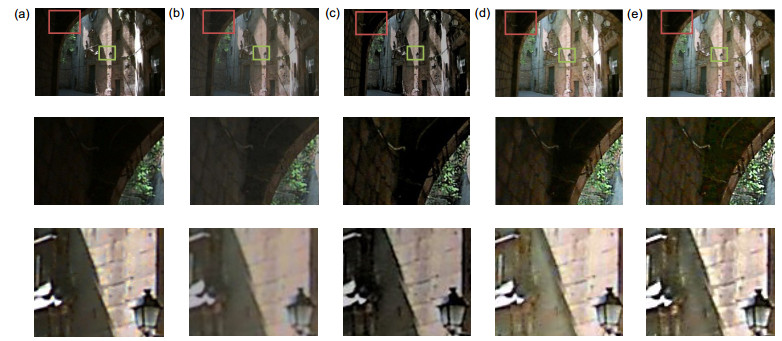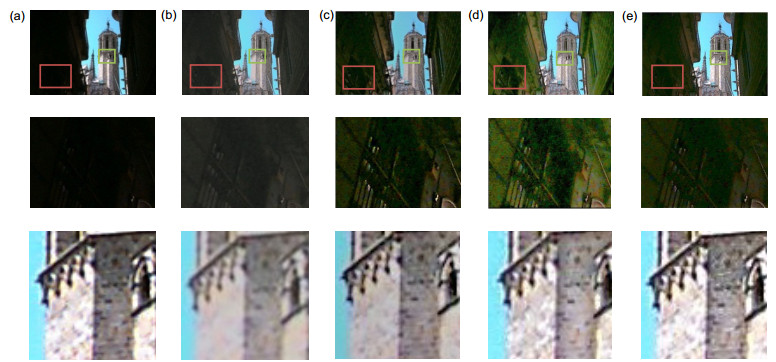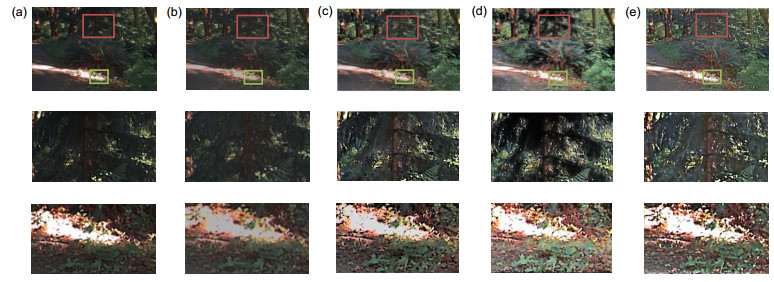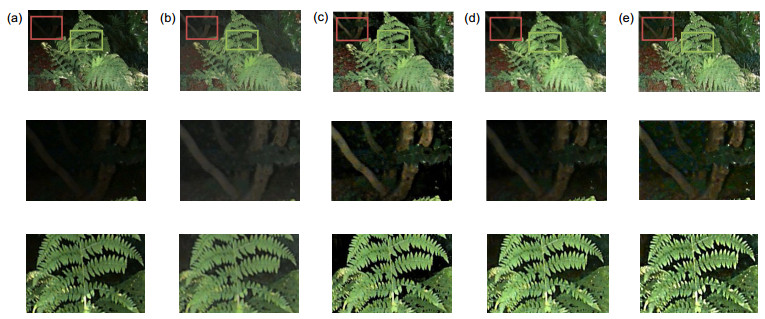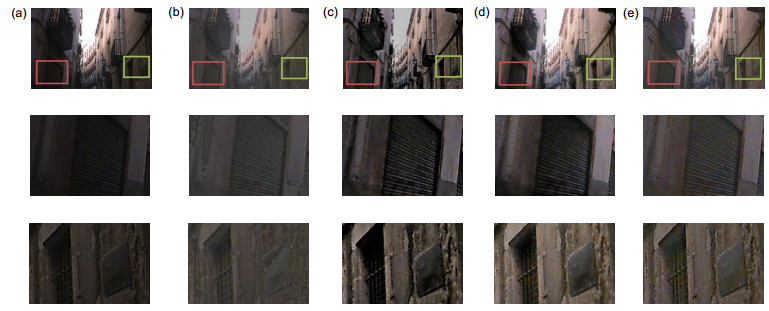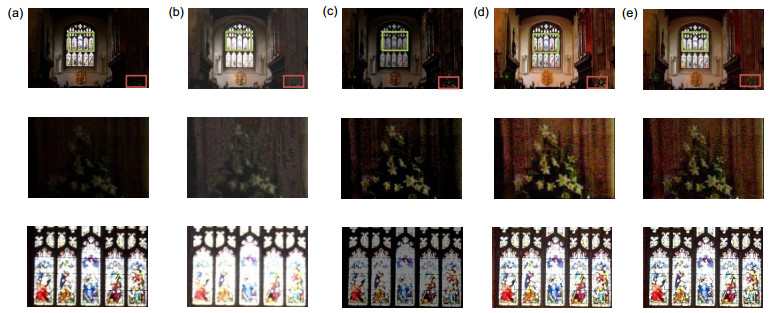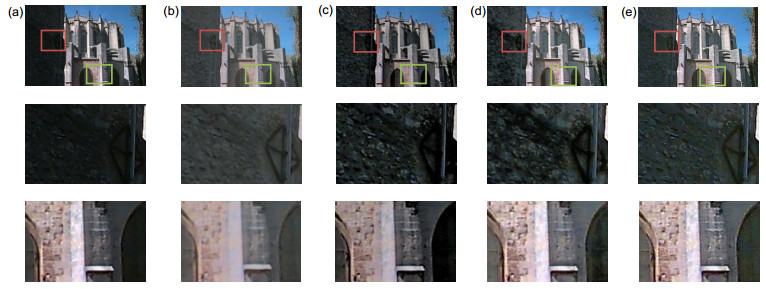Details preserved brightness equalization algorithm for non-uniform illumination images
-
摘要
针对目前图像增强算法应对非均匀光照环境的局限性,提出了一种同时保持低照度区域和正常照度区域细节信息的图像亮度均衡算法。算法利用像素相邻频率和位置关系生成光照滤波器,有效分离图像光照信息和反射细节信息。通过光照阈值划分光照亮暗区域进行低照度亮度补偿,从而均衡图像亮度。实验结果显示,相对于经典NPEA算法,图像平均峰值信噪比提升15.4%、平均增强度提升245.0%、平均亮度阶差下降25.4%。因此,本文算法能够在保持不同照度区域的细节信息的同时均衡亮度,获得较好的视觉效果。

Abstract
In order to overcome the limitation of current image enhancement algorithms for non-uniform illumination images, a brightness equalization algorithm is proposed to preserve the detail information in low illumination region and normal illumination region at the same time. The algorithm uses the adjacent frequency and position of pixels to generate illumination filter, so it can effectively separate illumination information and reflection information with details. The illumination threshold is used to divide different illumination areas to compensate for low illumination brightness, so as to balance the image brightness. The experimental results show that compared with the classical naturalness preserved enhancement algorithm (NPEA), the average peak signal to noise ratio of the image increases by 15.4%, the average enhancement degree increases by 245.0%, and the average brightness step difference decreases by 25.4%. The results of the proposed algorithm can maintain the details of different illumination areas while balancing the brightness and obtain a better visual effect.
-
Key words:
- image enhancement /
- brightness equalization /
- non-uniform illumination /
- detail preserved
-
Overview

Overview: Digital imaging is widely used in medical, surveillance, machine vision and other fields. Due to the limited light source during image acquisition, the captured image may have uneven illumination. The specific performance is low image local gray value, less dark area information and poor image visual effect, which affect subsequent judgment of image features.
In order to overcome the limitation of current image enhancement algorithms for non-uniform illumination images, a brightness equalization algorithm is proposed to preserve the detail information of low illumination region and normal illumination region at the same time. According to the Retinex theory, the gray value of any point in the image can be determined by the product of ambient illumination and reflectivity. Ambient illumination changes slowly with position, corresponding to the low frequency components of the image. Reflectivity depends on the object itself, reflecting the characteristics of the surface color and detail edges of the object. It contains the high frequency components of the image.
In this paper, an illumination filter for illumination estimation is designed by combining the adjacent frequency of the pixel with a conventional Gaussian filter. The basic idea of the illumination filter is that the influence of any neighborhood pixel in the image on the central pixel is not only related to the distance from the central pixel, but also related to the adjacent frequency of the values of the pixels on the image. It can effectively separate illumination information and reflection information with details. Then, the designed illumination compensator is used to process the illumination information which is mainly composed of low frequency components. The compensator uses illumination threshold to divide different illumination areas to compensate for low illumination brightness and adjust the overall illumination. The reflected and compensated illumination is combined to obtain an enhanced image with details retained.
Considering that in the process of image enhancement, the suppression effect of image brightness unevenness is closely related to the image information quantity, image quality, enhancement degree and naturalness maintenance effect, this paper uses four image evaluation factors (Entropy, PSNR, EME, and LOE) to objectively evaluate the image quality. The experimental results show that compared with the classical NPEA algorithm, the average peak signal to noise ratio of the image increases by 15.4%, the average enhancement degree increases by 245.0%, and the average brightness step difference decreases by 25.4%. The results of the proposed algorithm can maintain the details of different illumination areas while balancing the brightness, and obtain a better visual effect.
-

-
表 1 图像熵对比
Table 1. Performance comparison of Entropy
EBCE ACA NPEA 本文方法 图像1 6.7759 6.3986 7.3644 7.3908 图像2 6.0986 6.2287 6.9923 6.2990 图像3 6.1371 6.7247 7.1099 6.9896 图像4 5.5590 6.3906 7.4197 7.1557 图像5 6.5750 7.1734 7.0360 7.2182 图像6 6.6759 7.1319 7.6879 7.4086 图像7 6.0638 6.1719 6.9306 7.2879 图像8 7.3078 7.1795 7.7850 7.4435 平均值 6.7303 7.0599 7.5043 7.5045 表 2 图像峰值信噪比对比
Table 2. Performance comparison of PSNR
EBCE ACA NPEA 本文方法 图像1 19.2995 17.7274 16.3316 17.4192 图像2 18.3451 20.8345 15.5244 20.2428 图像3 23.2680 20.0979 13.9212 22.1396 图像4 22.5285 22.6555 11.1801 21.0813 图像5 20.1844 20.5146 20.4338 25.6804 图像6 17.5665 18.6475 15.8025 18.2134 图像7 14.6139 19.1116 14.6980 21.9548 图像8 18.1961 22.1573 21.7747 19.6659 平均值 16.7952 21.0702 18.8262 21.7162 表 3 图像增强度对比
Table 3. Performance comparison of EME
EBCE ACA NPEA 本文方法 图像1 29.1031 219.7958 69.5007 153.0762 图像2 19.1917 263.9296 75.3386 226.6238 图像3 51.7701 284.0402 93.9338 234.0508 图像4 39.6123 301.9907 110.9626 223.9246 图像5 42.6311 329.8859 133.8446 252.6182 图像6 18.2955 262.0133 56.6423 107.4543 图像7 38.6975 454.7314 97.8607 474.2258 图像8 24.7261 320.5474 81.1888 140.6896 平均值 42.3844 414.0190 104.2645 359.7217 表 4 图像亮度阶差对比
Table 4. Performance comparison of LOE
EBCE ACA NPEA 本文方法 图像1 0.3171 0.2465 0.1974 0.2389 图像2 0.4738 0.2735 0.3894 0.1406 图像3 0.5337 0.2836 0.3257 0.2193 图像4 0.5667 0.2281 0.3471 0.2120 图像5 0.4087 0.1823 0.0812 0.1645 图像6 0.4295 0.3687 0.2289 0.1935 图像7 0.4691 0.4880 0.2545 0.1197 图像8 0.3779 0.2131 0.2217 0.1785 平均值 0.4433 0.3416 0.1989 0.1484 -
参考文献
[1] Kim Y T. Contrast enhancement using brightness preserving bi-histogram equalization[J]. IEEE Transactions on Consumer Electronics, 1997, 43(1):1-8. doi: 10.1109/30.580378
[2] Wang Y, Chen Q, Zhang B. Image enhancement based on equal area dualistic sub-image histogram equalization method[J]. IEEE Transactions on Consumer Electronics, 1999, 45(1):68-75. doi: 10.1109/30.754419
[3] Chen S D, Ramli A R. Contrast enhancement using recursive mean-separate histogram equalization for scalable brightness preservation[J]. IEEE Transactions on Consumer Electronics, 2003, 49(4):1301-1309. doi: 10.1109/TCE.2003.1261233
[4] Tang J R, Isa N A M. Adaptive Image Enhancement based on Bi-Histogram Equalization with a clipping limit[J]. Computers & Electrical Engineering, 2014, 40(8):86-103. doi: 10.1016/j.compeleceng.2014.05.017
[5] Kim T, Paik J. Adaptive contrast enhancement using gain-controllable clipped histogram equalization[J]. IEEE Transactions on Consumer Electronics, 2008, 54(4):1803-1810. doi: 10.1109/TCE.2008.4711238
[6] Kim W, You J, Jeong J. Contrast enhancement using histogram equalization based on logarithmic mapping[J]. Optical Engineering, 2012, 51(6):067002. doi: 10.1117/1.OE.51.6.067002
[7] 芦碧波, 李玉静, 郑艳梅, 等.视觉自适应多尺度对数色调映射算法[J].小型微型计算机系统, 2017, 38(3):625-629. http://d.old.wanfangdata.com.cn/Periodical/xxwxjsjxt201703039
Lu B B, Li Y J, Zheng Y M, et al. A visual adaptive multi-scale logarithmic tone mapping algorithm[J]. Journal of Chinese Computer Systems, 2017, 38(3):625-629. http://d.old.wanfangdata.com.cn/Periodical/xxwxjsjxt201703039
[8] 陆许明, 朱雄泳, 李智文, 等.一种亮度可控与细节保持的高动态范围图像色调映射方法[J].自动化学报, 2015, 41(6):1080-1092. doi: 10.16383/j.aas.2015.c130202
Lu X M, Zhu X Y, Li Z W, et al. A brightness-scaling and detail-preserving tone mapping method for high dynamic range images[J]. Acta Automatica Sinica, 2015, 41(6):1080-1092. doi: 10.16383/j.aas.2015.c130202
[9] 李渤, 朱梅, 樊中奎, 等.非均匀光照图像自适应Gamma增强算法[J].南昌大学学报(理科版), 2016, 40(3):299-302. doi: 10.3969/j.issn.1006-0464.2016.03.017
Li B, Zhu M, Fan Z K, et al. An adaptive Gamma enhancement algorithm for non-niform illumination images[J]. Journal of Nanchang University (Natural Science), 2016, 40(3):299-302. doi: 10.3969/j.issn.1006-0464.2016.03.017
[10] 王殿伟, 王晶, 许志杰, 等.一种光照不均匀图像的自适应校正算法[J].系统工程与电子技术, 2017, 39(6):1383-1390. doi: 10.3969/j.issn.1001-506X.2017.06.29
Wang D W, Wang J, Xu Z J, et al. Adaptive correction algorithm for non-uniform illumination images[J]. Systems Engineering and Electronics, 2017, 39(6):1383-1390. doi: 10.3969/j.issn.1001-506X.2017.06.29
[11] Jobson D J, Rahman Z, Woodell G A. Properties and performance of a center/surround retinex[J]. IEEE Transactions on Image Processing, 1997, 6(3):451-462. doi: 10.1109/83.557356
[12] Rahman Z, Jobson D J, Woodell G A. Multi-scale retinex for color image enhancement[C]//Proceedings of 3rd IEEE International Conference on Image Processing, 1996, 3: 1003-1006.
[13] Lin H N, Shi Z W. Multi-scale retinex improvement for nighttime image enhancement[J]. Optik, 2014, 125(24):7143-7148. doi: 10.1016/j.ijleo.2014.07.118
[14] 赵宏宇, 肖创柏, 禹晶, 等.马尔科夫随机场模型下的Retinex夜间彩色图像增强[J].光学 精密工程, 2014, 22(4):1048-1055. doi: 10.3788/OPE.20142204.1048
Zhao H Y, Xiao C B, Yu J, et al. A Retinex algorithm for night color image enhancement by MRF[J]. Optics and Precision Engineering, 2014, 22(4):1048-1055. doi: 10.3788/OPE.20142204.1048
[15] Wang S H, Zheng J, Hu H M, et al. Naturalness preserved enhancement algorithm for non-uniform illumination images[J]. IEEE Transactions on Image Processing, 2013, 22(9):3538-3548. doi: 10.1109/TIP.2013.2261309
[16] 肖泉, 丁兴号, 王守觉, 等.有效消除光晕现象和颜色保持的彩色图像增强算法[J].计算机辅助设计与图形学学报, 2010, 22(8):1246-1252. http://d.old.wanfangdata.com.cn/Periodical/jsjfzsjytxxxb201008002
Xiao Q, Ding X H, Wang S J, et al. A halo-free and hue preserving algorithm for color image enhancement[J]. Journal of Computer-Aided Design & Computer Graphics, 2010, 22(8):1246-1252. http://d.old.wanfangdata.com.cn/Periodical/jsjfzsjytxxxb201008002
[17] Shannon C E. A mathematical theory of communication[J]. ACM SIGMOBILE Mobile Computing and Communications Review, 2001, 5:3-55. doi: 10.1002/j.1538-7305.1948.tb01338.x
[18] Agaian S S, Lentz K P, Grigoryan A M. A new measure of image enhancement[C]//IASTED International Conference on Signal Processing & Communication, 2000.
[19] Kong T L, Isa N A M. Enhancer-based contrast enhancement technique for non-uniform illumination and low-contrast images[J]. Multimedia Tools and Applications, 2017, 76(12):14305-14326. doi: 10.1007/s11042-016-3787-2
-
访问统计


 E-mail Alert
E-mail Alert RSS
RSS

 下载:
下载:
